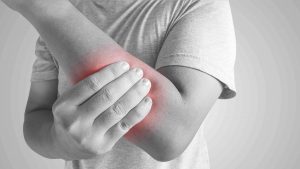Radial Nerve Pain
What causes Radial Nerve pain?
 Damage or irritation to the radial nerve usually stems from the same culprits including injuries such as fractures, non-cancerous fatty tumors call lipomas that obstruct the radial nerve, bone tumors causing compression on the nerve, inflammation of surrounding tissues, and overuse injuries from pushing, pulling, and grabbing.
Damage or irritation to the radial nerve usually stems from the same culprits including injuries such as fractures, non-cancerous fatty tumors call lipomas that obstruct the radial nerve, bone tumors causing compression on the nerve, inflammation of surrounding tissues, and overuse injuries from pushing, pulling, and grabbing.
Radial nerve pain has many causes and can originate in a few locations. The radial nerve originates off the base of the neck from the spinal cord in a group of nerves called the brachial plexus. As the radial nerve travels down through the shoulder and armpit in crosses through a section called the axilla. Damage to the radial nerve at the axilla can cause weakness in the arm and a condition called wrist drop. A common cause of nerve pain in from the axilla would be nerve compression from the improper use of crutches. The nerve after leaving the armpit wraps around the humerus in a groove called the spiral groove. Sources of radial nerve pain from this region of the pathway occurs from fractures or compression to the inside of the upper arm. One source of compression like this stems from falling asleep with your arm resting on the back of the couch or chair. Spiral groove sources of radial nerve damage manifest with difficulty in bending the wrist back and trouble straightening the fingers. Right before the radial nerve passes through the elbow the nerve branches off into the Posterior Interosseous. The posterior interosseous if damaged does not cause any pain since it has no sensory function. The only symptom will be a loss of the ability to straighten your fingers from a loss of strength with out any pain. The main branch of the radial nerve continues down the wrist and the back of the hand and only has sensory functions. Damage to this part of the radial nerve produces pins and needles sensations in the back of the hand.
Radial tunnel syndrome
All individuals process pain differently which can lead to individuals reporting a variety of symptoms. Many individuals suffering from radial tunnel syndrome report cutting, piercing, or stabbing pain at the top of the forearm or back of the hand. This pain amplifies when attempting to straighten the wrist and fingers. In contrast to cubital tunnel syndrome and carpal tunnel syndrome, radial tunnel syndrome rarely causes numbness or tingling due to the radial nerve principally affecting the muscles.
Individuals experiencing wrist pain should seek the medical opinion from a hand and wrist specialist. To diagnose radial tunnel syndrome, the provider conducts a physical examination of the patient. The doctor asks about medical history, family history, and tries to get an idea of the everyday life of the patient. The provider then performs physical tests of the hand and wrist. The doctor may order diagnostic testing to check for any underlying issues and rule out other possible ailments.
Conservative treatment of radial nerve pain
 Conservative treatment of radial nerve pain starts with RICE (rest, ice, compression, elevation) paired with over the counter NSAIDs. If first aid does not render you with any relief you should visit an orthopedic surgeon to obtain a diagnosis and try more powerful treatments such as oral steroids, intramuscular steroid injections, accompanied with specific physical therapy. If these methods do not give you relief then your surgeon would discuss surgical intervention to alleviate your symptoms.
Conservative treatment of radial nerve pain starts with RICE (rest, ice, compression, elevation) paired with over the counter NSAIDs. If first aid does not render you with any relief you should visit an orthopedic surgeon to obtain a diagnosis and try more powerful treatments such as oral steroids, intramuscular steroid injections, accompanied with specific physical therapy. If these methods do not give you relief then your surgeon would discuss surgical intervention to alleviate your symptoms.
Surgical treatment of radial nerve pain
If the patient’s symptoms do not improve with conservative treatment and time, the doctor may suggest surgical intervention. An uncommon procedure, radial tunnel surgery has various outcomes according to surgeons. During radial tunnel surgery, an anesthesiologist places the patient under general anesthesia. Under general anesthesia, the patient remains asleep for the duration of the surgery. The surgeon then performs a radial tunnel release which involves dividing the compressive sites in the radial tunnel, providing more space for the radial nerve. This prevents the nerve from pinching.
Suffering from Radial Nerve Pain? Contact AOA Orthopedic Specialists today! 817-375-5200
F.A.Q.
What is Radial Nerve Pain?
Radial Nerve Pain, also known as radial neuropathy, is a condition that occurs when the radial nerve, which runs down the arm and controls movement in the triceps muscle, wrist, and hand, becomes compressed, irritated, or damaged. This can lead to symptoms such as pain, weakness, or numbness in the back of the hand, thumb, and fingers. It may also affect grip strength and fine motor skills.
What are the Common Causes of Radial Nerve Pain?
Radial Nerve Pain can be caused by various factors, including trauma or injury to the arm, prolonged pressure on the nerve, repetitive activities that strain the arm and wrist, or certain medical conditions like radial tunnel syndrome. Fractures, dislocations, or soft tissue injuries in the upper arm can also contribute to this condition. If you’re experiencing symptoms, it’s important to consult with an orthopedic specialist for a proper diagnosis.
How is Radial Nerve Pain Treated?
Treatment for Radial Nerve Pain depends on the underlying cause and severity of the condition. Conservative approaches may include rest, physical therapy, anti-inflammatory medications, and splinting to reduce pressure on the nerve. In some cases, surgical intervention may be necessary to release the compressed nerve or repair damaged structures. Your orthopedic specialist will perform a thorough evaluation and recommend a tailored treatment plan to alleviate your symptoms and improve function.

